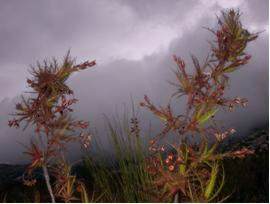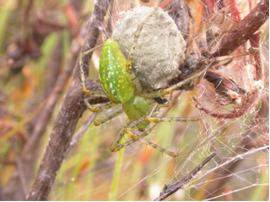Roridula dentata
Roridula dentata L.
Family: Roridulaceae
Common names: flycatcher bush, bug plant, fly bush (Eng.); vliëebos (Afr.)
Introduction
Roridula dentata is a tentacle-leaved shrub that has a unique symbiotic relationship with the assassin bug, Pameridea marlothii. Although commonly known as the flycatcher bush, this plant does not consume the insects it traps but rather provides food for its insect guests. It has been known to catch small birds!

Description
Description
Roridula dentata is a shrub up to 2 m high. The leaves are lanceolate having margins with teeth and tentacles, and are covered with numerous sticky hairs of different lengths and covered with a gummy glue-like substance. The flowers are pink and are borne on the ends of hairy pedicles in the axils of the upper leaves. Flowering time is in spring and early summer (September to October) in the southern hemisphere. Plants do not live long and bush fires initiate seedling germination.
Conservation Status
Status
Roridula dentata is currently not listed on the South African Red Data List of 1996. However, the Millennium Seed Bank team based at Kirstenbosch are working with the Threatened Species Programme (TSP), currently revising the Red Data List under IUCN guidelines.
It has been noted that although this shrub had a wide distribution historically, many populations listed in herbaria are no longer in existence. This is due to too frequent fires; fires at the wrong season when seeds are germinating; and habitat destruction by agriculture.
With the data now at hand it is envisaged that Roridula dentata may be given a status of Vulnerable (VU) or even Endangered (EN). Although seed from this species is known to have an ample longevity in storage, the parent plant often does not produce large quantities of seed. Thus there is often insufficient seed for seed banking and also to regenerate the soil seed bank in situ.
The most devastating threat to R. dentata populations is farming, specifically of rooibos, which is one of the only crops that can be grown in the mountains of the Cape, in the same habitat as this species. Due to the unique relationship of R. dentata with the insect, Pameridea marlothii, both species are rare or threatened: Pameridea marlothii occurs only on R. dentata, a leggy insect that may hold the key to the growth and pollination of this perennial shrub.

Distribution and habitat
Distribution description
Found at altitudes of 900-1200 m in the Cape Fold Mountains of Clanwilliam, Ceres and Tulbagh, Roridula dentata prefers moist, damp localities and is generally found in habitats such as bogs, marshes and on the banks of rivers. Although occurring in very moist habitats, the biome type is arid mountain Fynbos and annual temperatures average 27 ° C. The dry summer winds and low rainfall make this an extremely harsh environment to survive in, yet Roridula dentata is very tolerant of these conditions.
Derivation of name and historical aspects
History
The genus name Roridula is derived from the Latin rorida meaning dewy, wet with dew, and the specific epithet from the Latin dentata for toothed, alluding to the wet, toothed leaves. The family Roridulaceae consists of only one genus Roridula, which has only two species, both endemic to the Western Cape province: R. gorgonis and R. dentata.
Ecology
Ecology
Although the sticky sap on the leaves of R. dentata traps insects, the sap lacks enzymes to digest them, unlike the sundews, Drosera. Instead, R. dentata has a unique species-specific symbiotic relationship with the assasin bug, Pameridea marlothii. This insect, with its specially adapted feet, is able to live on the R. dentata plant and run freely over the sticky sap.

On finding a trapped insect, the assasin bug probes the hapless victim with its proboscis, injecting venom until the prey succumbs and dies. The nitrogen-rich excretory waste products of the assasin bug provide fertilizer for the R. dentata plant.
This species of assassin bug occurs nowhere else in the world and is thus also threatened. It needs R. dentata to trap its food in order to mature and reproduce and the R. dentata plant needs the juvenile bugs to pollinate the flowers whilst crawling around for food.
It has also been noted that bees visit the flowers and allow pollination between different plants, without being trapped. This symbiotic relationship allows for both the insect and plant to obtain food through the other's actions.
Growing Roridula dentata
Grow
This plant is best grown from seed and must be sown in April and May, as these months have hot daytime temperatures and cooler night temperatures. An ideal pot specimen, Roridula dentata should be kept in a warm sunny spot on a balcony or window sill. Unless you know an entomologist who could supply you with some assassin bugs the best is to feed your plant with a liquid fertilizer high in nitrogen. Treat the seeds with Kirstenbosch Smoke Primer and then sow into trays or pots containing equal parts milled pine bark (or palm peat) and medium river sand. Place the seeds on the surface of the medium and lightly cover with a layer of sand; don't plant them too deep. Germination can take up to three months, so don't throw out your medium after a couple of weeks if nothing has come up!
Although this plant has a reputation for being hard to cultivate, with the correct care it can thrive; the main cause of plant loss is over-watering. As R. dentata occurs in an arid habitat (hot dry summers), it is recommended that you mist these plants with a fine spray during the summer months rather than drenching them with a watering can when they look dry.
References
- Leistner, O.A. (ed.). 2000. Seeds plants of southern Africa : families and genera. Strelitzia 10. National Botanical Institute, Pretoria.
- Reiner, M. 2003. Cultivation and description of Roridula gorgonias and Roridula dentata. www.drosophyllum.com
- Smith, C.A. 1966. Common names of South African plants. Memoirs of the Botanical Survey of South Africa No. 35.
- Website: The largest carnivorous plant grows on our doorstep. http://fernkloof.com/other.mv
Credits
Carly Cowell
Kirstenbosch NBG
September 2007
Plant Attributes:
Plant Type: Shrub
SA Distribution: Western Cape
Soil type:
Flowering season: Spring, Early Summer
PH:
Flower colour: Pink
Aspect: Full Sun
Gardening skill: Challenging
Special Features:
Horticultural zones








Rate this article
Article well written and informative
Rate this plant
Is this an interesting plant?
Login to add your Comment
Back to topNot registered yet? Click here to register.